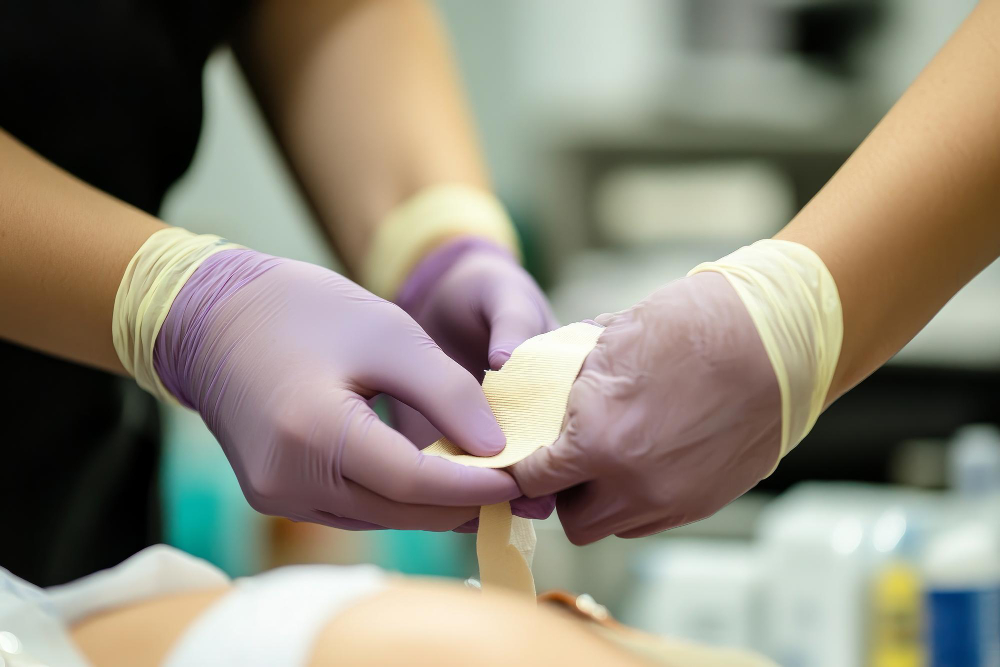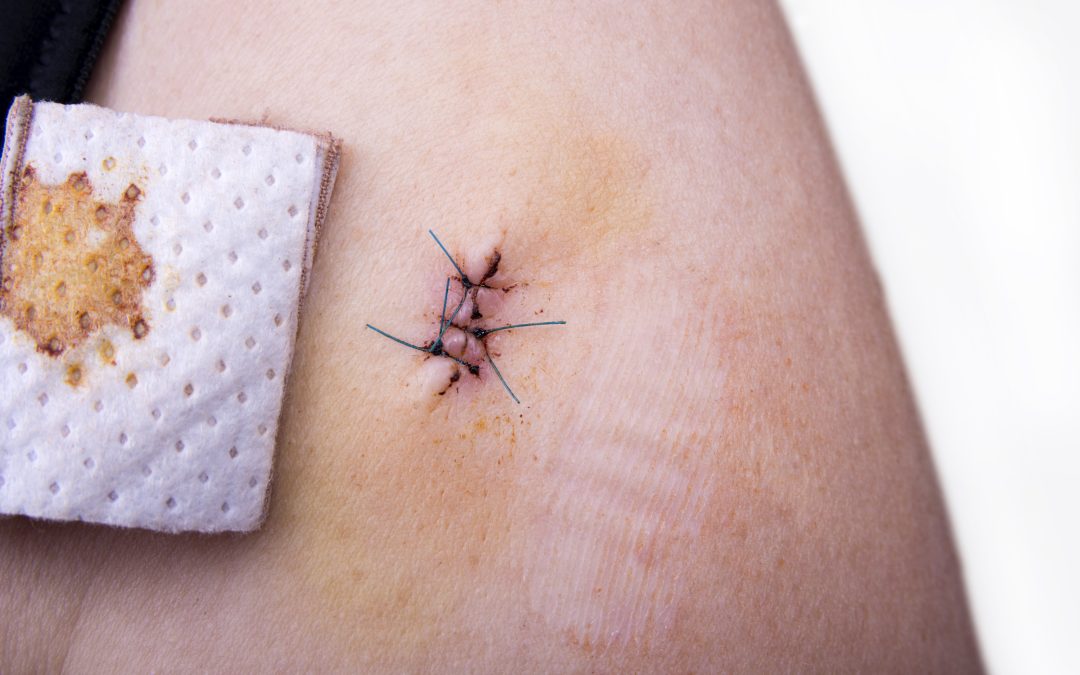In Chicago, urgent care clinics and hospitals commonly use non-dissolvable stitches, also known as non-absorbable sutures, to close deeper wounds, surgical cuts, or injuries that require long-term support.
These stitches are manually removed once healing is complete and are typically stronger than dissolvable types.
Unlike dissolvable stitches that break down naturally in the body, non-dissolvable ones stay in place until your provider removes them. This makes them ideal for areas under tension or where durability matters—such as joint injuries, deep cuts, or external surgical sites.
What Materials Are Used?
Non-dissolvable stitches are made from synthetic or natural materials that do not break down inside the body. They’re designed to resist moisture and inflammation, ensuring the wound stays closed throughout the healing process.
Common materials include:
- Nylon – durable and flexible, often used on skin closures
- Polypropylene – robust and less likely to cause irritation
- Silk – a natural fiber sometimes used for soft tissue closures
- Polyester – braided for added strength and stability
These materials are carefully selected based on location, wound type, and patient needs. In many Chicago-area clinics, nylon and polypropylene are the most frequently used due to their strength and minimal tissue reaction.
Doctors Prefer Non-Dissolvable Stitches
Doctors across Chicago prefer non-dissolvable stitches when a wound needs longer-lasting support and won’t heal quickly on its own.
These stitches are especially helpful for closing deeper cuts or wounds in high-movement areas, such as the hands, knees, or elbows, where the skin is under constant tension.
Non-dissolvable sutures are also commonly used in surgical incisions, traumatic injuries, or occupational wounds that need extended closure time to prevent reopening. Unlike absorbable stitches, these stay intact until a healthcare provider manually removes them—ensuring the wound remains sealed during the critical healing window.
They’re often used in:
- Surgical incisions
- Deep lacerations or trauma
- High-movement joints like knees, fingers, or elbows

Why Non-Dissolvable Over Dissolvable?
If the wound is on the skin surface or prone to reopening, non-dissolvable stitches are stronger and more secure compared to absorbable ones.
How Long Do Non-Dissolvable Stitches Stay In?
The amount of time non-dissolvable stitches stay in depends on the location of the wound and the rate of healing. In most cases seen at urgent care clinics in Chicago, stitches are kept in for 5 to 14 days.
Some scars may require more time—especially if they’re deeper, located over joints, or healing slowly due to movement or an increased risk of infection. Doctors typically recommend a follow-up visit within one to two weeks to examine the healing progress and determine the optimal time for removal.
Removing stitches too early can cause the wound to reopen, while leaving them in for too long may lead to skin irritation or visible scarring from the stitches.
For instance:
- Face wounds: removed in 5–7 days
- Joints or limbs: 10–14 days
- Deeper or surgical sites: follow specific post-op instructions
Signs Your Stitches May Be Ready for Removal
- Skin is closed with no gaps
- Redness and swelling have decreased
- No pus or discharge is present
Always consult your healthcare provider before removing any stitches.
What Happens If They Aren’t Removed on Time?
Leaving non-dissolvable stitches in too long can lead to several complications, especially if the wound has already healed. In many Chicago clinics, providers emphasize the timely removal of stitches because prolonged stitching can cause skin irritation, scarring, or even infection.
The longer the stitches remain in place, the more likely they are to become embedded in the skin, making removal more difficult and painful. Neglecting follow-up care might also increase the risk of the wound reopening or healing improperly.
This is especially concerning in high-motion areas, such as the knees, hands, or elbows, where tension can pull the skin apart if stitches aren’t removed when needed.
Risks of Delayed Removal
- Stitches may become embedded in the skin
- Delayed healing or scarring
- Risk of wound reopening if the skin weakens around it
If you’re unsure when to return for removal, refer to guides on how to care for wound stitches
How Are Stitches Removed?
Removing non-dissolvable stitches is a quick and simple procedure performed at urgent care centers or medical clinics across Chicago. It’s usually done in-office with sterile tools and causes minimal discomfort. In most cases, the process takes less than 10 minutes and doesn’t require anesthesia.
Your provider will inspect the wound to ensure it has healed enough, then gently snip and remove each stitch. You might feel a slight tug, but the procedure is generally painless.
Afterward, they’ll clean the area and provide you with instructions on maintaining the site’s cleanliness as it continues to heal.
1. What to Expect During Your Visit?
When you arrive for stitch removal, a provider will first check that no redness, swelling, or open areas remain. They may ask about your healing progress or discomfort levels before proceeding.
2. The Removal Process Step-by-Step
- The provider uses sterile scissors or forceps
- Each suture is snipped and gently pulled out
- The area is cleaned and sometimes covered with a bandage
Most patients feel just a mild pulling sensation, not pain.
3. Aftercare Once Stitches Are Out
You’ll receive aftercare tips to prevent infection or scarring. This usually includes:
- Keeping the area clean and dry
- Avoiding sun exposure on the scar
- Watching for any delayed signs of infection
Patients are advised to keep the site clean and dry after removal and to watch for any signs of infection, such as redness or oozing.
Care for Stitches Until They’re Removed
Taking proper care of your stitches is essential for preventing infection, minimizing scarring, and promoting a smooth healing process. Whether you got your stitches at a Chicago urgent care clinic or hospital, the first few days are the most critical.
Keeping the area clean, protected, and dry can prevent complications and ensure your wound stays sealed. Avoid tugging, scratching, or bending the area too much—especially if the stitches are near joints or places that move often.
Follow any specific instructions your provider gave you and reach out if you notice increased redness, pus, or pain.
Basic Aftercare Tips
- Keep the area clean and lightly covered
- Avoid soaking the wound in water
- Do not tug, scratch, or remove the stitches yourself
For more, read the article on how to relieve pain from wound stitches and follow all clinic aftercare instructions.
When Are Non-Dissolvable Stitches Used?
These stitches are usually used when the wound:
- It is located on the skin surface
- Needs long-term support to avoid reopening
- Is exposed to high movement (like joints or hands)
They’re also standard in occupational medicine procedures where durability is a priority. You can expect these stitches to be removed during a follow-up visit, typically within 5 to 14 days, depending on the location of the site.
Stitches Cause Discomfort
Non-dissolvable stitches are designed to stay in place longer than absorbable ones, so it’s common for patients to feel some minor discomfort during the healing process.
It may include itching, tightness, or a pulling sensation, especially in areas that move frequently, like joints or fingers. However, this discomfort is usually mild and manageable with proper care. Since these stitches remain in the skin until removal, they may also cause irritation if left in too long, become infected, or be exposed to moisture or friction.
That’s why routine cleaning, bandaging, and follow-up appointments are crucial in reducing the risk of complications.
1. Mild Itching Is Normal
A slight itching around the stitched area is part of the body’s natural healing process. But scratching can irritate the wound or even pull the stitches, so it’s essential to avoid touching the area directly.
2. Tightness or Pulling Sensations
As the skin tightens during healing, you might feel a slight pulling or stretching—especially when moving nearby muscles. It is normal and typically lessens as the wound closes.
3. Discomfort May Signal a Problem
If the pain worsens, the area becomes red or swollen, or you notice discharge, it may indicate an infection or irritation. In that case, consider visiting a local provider or consulting with them to learn how to relieve pain from wound stitches for guidance.
For Detailed Information:
What are the risks of wound stitches?
How to relieve pain from wound stitches
Can wound stitches cause itching?
Learn More from MedlinePlus:
For trusted medical info about stitches, suture materials, and healing:
MedlinePlus – Stitches and Sutures
FAQs
What are non-dissolvable stitches?
They are stitches made from synthetic or natural material that don’t break down in the body and must be removed manually.
Why are they used instead of dissolvable ones?
They provide stronger and longer-lasting support, especially in high-motion areas or for external wounds.
What materials are most commonly used?
Nylon, polypropylene, polyester, and silk are widely used materials, depending on the type of wound.
Do these stitches hurt when being removed?
Most patients report only mild discomfort or a tugging feeling during removal.
How long should I keep them in?
It varies, usually 5–14 days, depending on the wound’s location and the rate of healing.
Can I shower with non-dissolvable stitches?
Yes, but avoid soaking. Always follow your provider’s aftercare instructions.
Are they safe for all skin types?
Yes, but individual skin sensitivity may vary. Your provider will select the most suitable material for you.
What if a stitch comes loose early?
You should visit a provider promptly to avoid the wound reopening or becoming infected.
Can these stitches cause itching?
Yes, it’s common. Learn how to manage itching safely without scratching the area.
Where can I get stitches in Chicago?
You can get professional wound care at local clinics like 1st ChoiceMed throughout the Chicago area.

